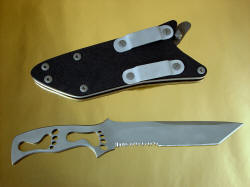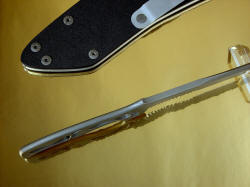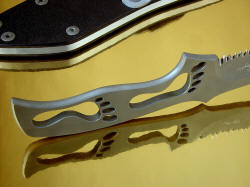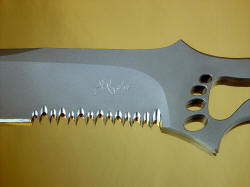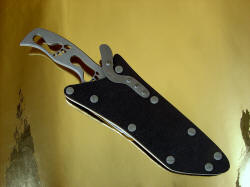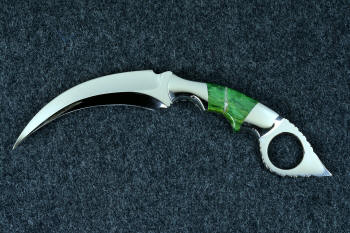PJSK Viper
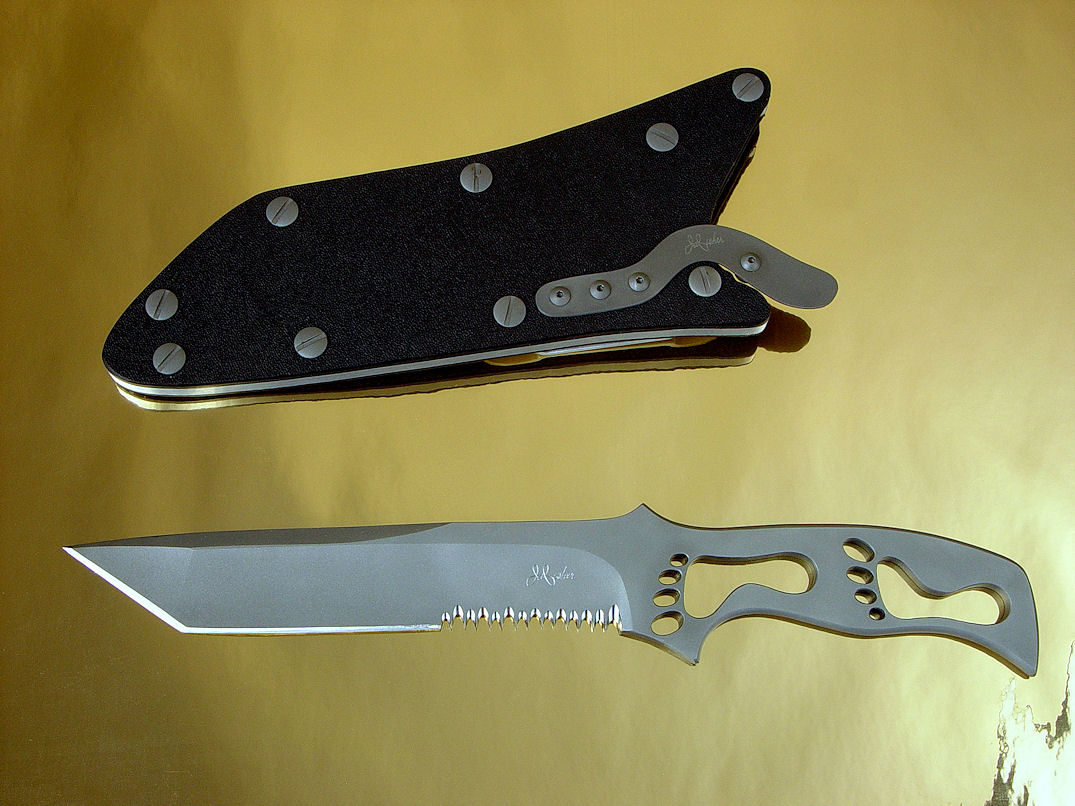
"PJSK Viper" Skeletonized Tactical Combat,
Rescue Knife
- Size: Length overall: 12.1" (30.7 cm), Blade Length: 6.8" (17.3 cm), Thickness: .233" (5.9 mm)
- Weight: Knife: 9.3 oz. (264 grams), Sheath: 10.5 oz. (298 grams)
- Blade: ATS-34 High Molybdenum Martensitic Stainless Tool Steel, Hardened and Tempered to Rockwell C59, Bead Blasted
- Sheath: Hybrid Tension-Locking in Black Kydex, Aluminum, Stainless Steel, Titanium
- Knife: Answering requests for an ultra light,
yet ultra strong and functional tactical combat knife, the Viper
series is the latest evolution of my fine tactical combat knives. Military
clients have requested a speedy, quick, yet formidable
knife capable of quick and superior function, also asking me to do
everything I could to lighten the weight while preserving
functionality and durability I'm known for. The Viper
series is a great example of the cooperation between warriors,
rescue professionals, and
weapons maker, and I offer these same knives to my clients so that
they, too, can benefit from this refinement when in need of a
lightweight, small footprint, and thin knife and sheath combination.
I'm certain that these knives will be highly desirable and sought
after by many branches of service and professional users of tactical
equipment as well as civilians who need a lightweight yet extremely
durable knife capable of a variety of cutting tasks. This
particular design is named the PJSK (Pararescue Jumper SKeletonized)
Viper.
I started with a steel that could offer great toughness
(resistance to breakage) at a high hardness and high
wear-resistance, while being corrosion resistant enough for harsh,
marine (salt water), and corrosive exposures. This knife is made of
ATS-34 a high molybdenum, high chromium (chrome-moly) tool steel
that has a long-proven reputation for its tough character. The blade
is a design derived from my other Pararescue knives, the PJ, and the
PJLT, my most popular knife. It has a
deeply hollow ground blade and half-length top swage that offers a
tough and angular point for piercing with the durable tanto
blade geometry proven by Pararescue use. The blade has a over 2" of
my Vampire rip tooth serrations, the most aggressive and pointed serration
I offer. The Vampire serrations were derived from military requests
for "teeth that keep ripping and tearing, even if broken off." An
added advantage of this type of serrations is
trapping and defense.
The serrations will trap, snag, and capture line and other textiles
for cutting, and in a defensive situation, the points of this
particular serration can not be grasped by an enemy, even with
gloves on. The
spine and blade stock is very thick for this size of knife, and I
used a special new pattern milling process that removes most of the
handle weight while leaving a stout and substantial spine to support
the handle-to-blade junction. This milling is done by hand, not with
a CNC machine, which makes it easier to create many custom handmade
designs and patterns at a reasonable cost and time frame, keeping
the knives completely handmade. For the knife user, it means a
skeletonized knife that is substantially robust and tough, yet
light, quick, and sharp. The design chosen for this knife is the
PJ "footprint," derived from the "Jolly Green footprint," an
unofficial emblem of Pararescue. All of the surfaces in contact with the
hand are rounded, contoured, radiused and dressed so that the handle
is as comfortable as possible with such a thin knife. The inside cuts
of this handle are carefully considered to yield just the right
orientation and size to maintain tang strength while looking
very cool. The handle milling is lightly chamfered so
there are no sharp or abrasive corners to contact the user's hands. The
thumb rise and the forward quillon is substantial enough to keep a
sure grip. The entire knife blade is
media-blasted for zero glare, and my maker's mark is deeply
diamond-engraved for permanence. A nice feature of the skeletonized
knives is cleanliness, as there is absolutely no area for dirt,
chemicals, or debris to remain, and the knife can be dropped into a
dive rinse tank with detergent cleaners for a thorough scrubbing
when needed.
The gentle slope of the knife butt accommodates the thick area of the palm,
and the rear quillon can double as a persuader or talon if needed.
Of course, a lanyard is an easy option. The knife feels extremely
light and effective in forward or reverse grip, and the balance
point is exactly at the thumb rise. More about
skeletonized knives on this special page.
- Sheath: The sheath is very special, a new and
exciting development made just for my skeletonized knives, and an
example of my commitment to the entire knife experience, from design
to working service. This is a proprietary design, and without giving
away the exact details of the build, I will claim that (like my
other sheaths) it is the best possible sheath of its type available
in the world today. Actually, it is the ONLY type of this sheath
available in the world today! The sheath is built of double thickness (.125"
thick) kydex (methyl acrylate and polyvinyl chloride) over a
welt-frame of 5052H32 corrosion resistant high strength aluminum
alloy. The sheath is bonded with waterproof cement and bolted
together with all 304 stainless steel Chicago screws for zero care
and extreme corrosion resistance. The sheath (like most of my
sheaths) has die-formed aluminum belt loops that are able to be
moved to multiple locations as well as either side of the sheath
frame. On this particular knife, the belt loops have 16 optional
locations for versatile wear.
My newest and most exciting development is my hybrid tension-locking
mechanism. This device is custom made to fit each knife, and allows
a lock pressure of 15 pounds to hold the knife in the sheath, with
an optional thumb or finger release. There are two options to
unsheathe:
1. placing your hand on the knife handle in forward
(traditional) grip and use the finger or thumb to operate the release
and
unlock the knife for a slow, controlled, or quiet extraction of the
knife.
OR
2. grabbing the knife handle and pulling hard, with at
least 15 pounds of tension, the knife is unsheathed.
Simply put, the knife can be unlocked manually, or yanked hard and
unsheathed. 15 pounds is quite a bit of force, so the knife is
locked into the sheath unless it encounters 15 pounds of pull. This means that in most circumstances, the knife stays
locked in the sheath, and the assembly can trustfully be mounted
upside down or used in highly active movement with relative security. To be
certain that the knife is locked in the sheath properly, it takes a
thumb operation to re-engage the locking mechanism. All of the
components in this proprietary system are corrosion resistant
stainless steel or titanium, and the entire assembly is even
reversible by the owner! It's simple, it's lightweight, it's fast,
and it's clean, and it's all non-glare. I'm certain that it will be a leading sheath for
the skeletonized knife made for our tactical combat
professionals for many years to come.
- Accessories: Since the bolt pattern of the
sheath matches our 2.5" bolt pattern for our accessories, most of
our accessories can be used on this sheath, including any new ones
we develop. While heavy and bulky accessories like our extenders and
HULAs are not practical, accessories like the horizontal belt plate
adapters may be a useful adjunct.
- This is the lightest weight, fastest, most durable skeletonized
CSAR knife made in the world today. Highly effective and proven
blade and edge geometries presented in unique and striking handle
milling makes this a very special working knife and tool for
tactical use, rescue, and survival.
Thanks, P.K.!
The knife is functional, clean and easily maintained. The sheath protects the weapon,
secures and allows for various ways to carry it. This sheath allows for any type of transport
to be used without having to worry about the knife coming out of the sheath or falling off a belt.
Overall an excellent knife and sheath.
--P.K.
Please click on thumbnail knife photos
